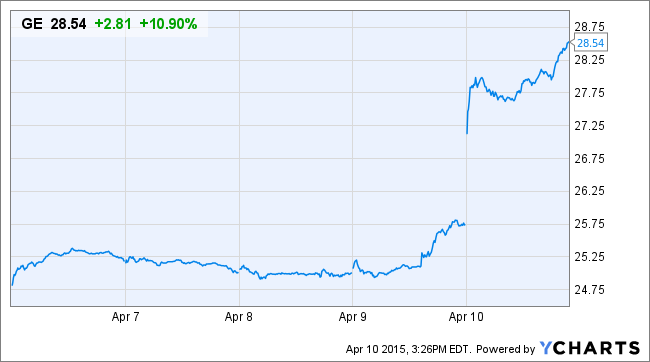This morning, in a story first broken by the New York Times, General Electric (GE) announced that it would?divest itself of nearly all its GE Capital assets over the next two years. ?This news came on the heels of a widely-disseminated market rumor that GE was in talks with several companies to divest its real estate assets, and in fact, the company formally announced this action?today as well. The market took this news well, sending the share price up by nearly 14% compared to the April 8 close–a formidable increase for such a large market capitalization stock.
Because a large portion of our portfolio is allocated to an investment in GE, we were pleased to see such a large price jump; however, the headline that GE planned to divest itself of GE Capital surprised us, since we had framed GE Capital as an important strategic asset in our IOI Institutional Report on General Electric. Readers will know that our view of the importance of GE Capital was not in its profitability (which was lower than several other business lines) or its returns (which were decidedly uninspiring), but in its capacity to shelter profits generated by?GE’s main businesses from U.S. tax obligations.
A quick look at GE’s press release assured us that GE had left its tax sheltering structures in place. The second bullet point in the announcement was
[General Electric p]lans to retain financing ‘verticals’ that relate to GE?s industrial businesses.
Our understanding of the company leads us to believe that these financial service verticals in fact enable a significant portion?of the tax sheltering structures put in place by GE. For example, the aviation leasing business might sell a fully depreciated aircraft to a related partnership that leases airplane back to GE on a capital lease.?The GE subsidiary entering the capital lease agreement once again starts the depreciation clock running and the depreciation-related tax shelter flows up through the organization, thus enabling overall corporate taxes to be lowered.
In other words, GE ends up getting a nearly perpetual depreciation tax shelter on the same aircraft or other piece of equipment. These complex leasing structures span multiple overseas tax jurisdictions, so can be arranged in such a way to allocate profits from the sale of a piece of equipment to a low tax country, then allocate the depreciation-related tax shelter to consolidated subsidiaries as a way of lowering U.S. corporate taxes.
It’s not pretty, but these type of structures have been upheld in various court cases.
In short, GE is retaining the structures that will allow it to shelter profits from U.S. tax while reducing investor uncertainty regarding the company that comes with having a significant commercial leasing portfolio.
GE also announced a massive stock buyback plan, and it is likely this buyback plan, in addition to the reduced uncertainty regarding GE Capital, that is sending the shares higher today. With the publication of GE’s 2014 10-K, I have been analyzing the effect of buybacks on the shareholders’ store of profits and will publish another article on that topic shortly. In the meantime, it’s a nice?day to be long GE stock.

